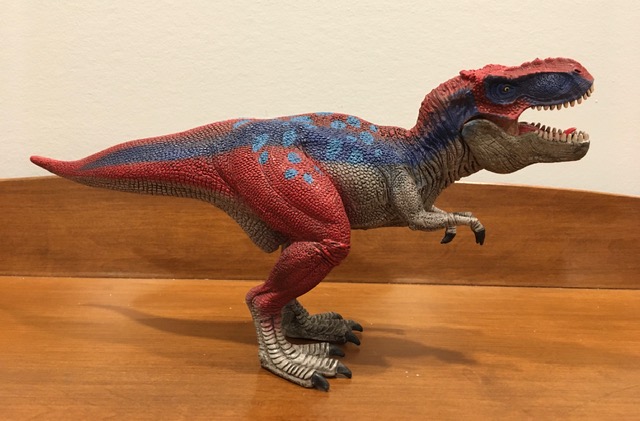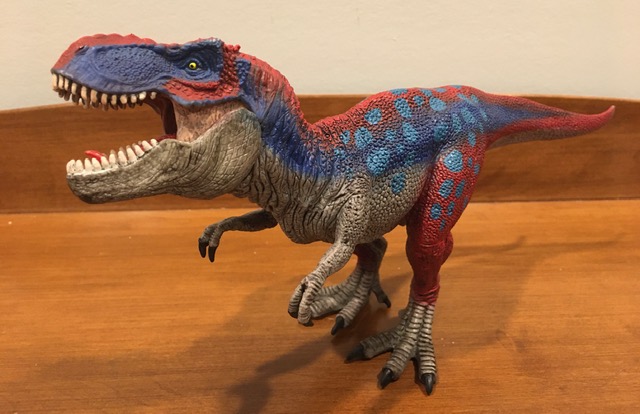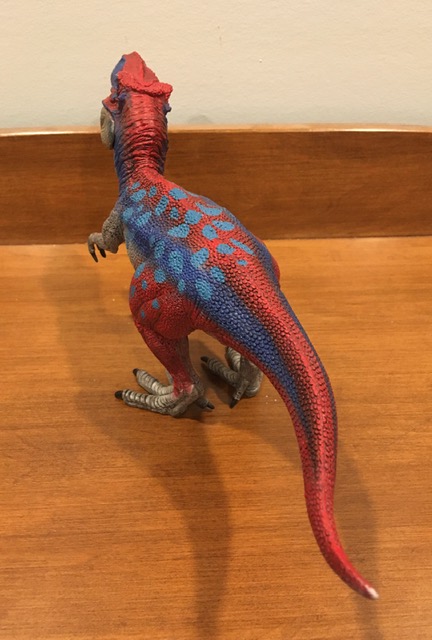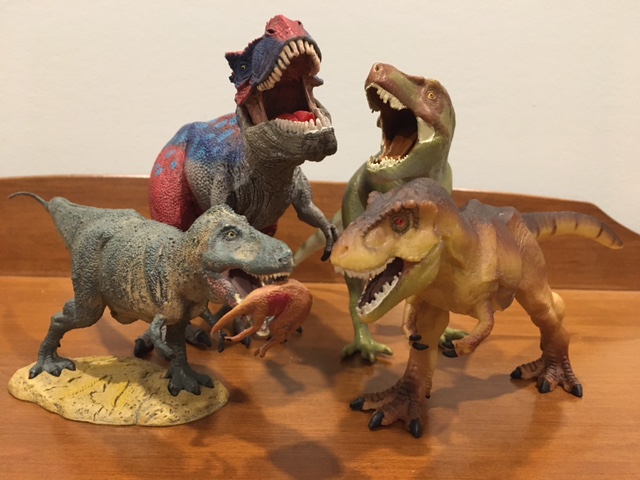Schleich can be seen as the equivalent of McDonald’s in that, despite the sometimes lacklustre quality of their products, they are still the most globally successful of all the companies specializing in PVC scale models of extinct and extant fauna. Take for example their 2012 Tyrannosaurus rex mould. It’s by no means the most impressive or the most accurate rendition of the world’s greatest dinosaur, but it’s proven to be such a popular seller that Schleich has repainted it no less than five times (as far as I’m aware of) over the past decade. There’s been a red version, a gold one, a blue and yellow one packaged with a volcano playset, and most recently a black one. And here I’ll be looking at what is arguably the most striking of all the repaints.

Here in Canada, this particular T. rex was released in 2020 exclusively to Indigo, a successful book, toy, and gift chain. It has since become available on Amazon Canada as well. The original 2012 release was covered here on the blog that same year and there’s really nothing I can add to that review in terms of sculpting detail. Although I will note that, in addition to the glaring inaccuracies with the head and limbs, the tail is much too short and stumpy.

So let’s talk about that colour scheme. The eyes are yellow, the teeth are pinkish-white, and the inside of the mouth and the tongue are pink and red respectively with black wash. A shade of flat grey is used for the lower jaw, throat, arms, feet, and underbelly, all again with black wash to bring out the detail. So far, so good. Nothing peculiar about any of that.

But the same cannot be said for the rest of this T. rex. A striking shade of crimson red adorns the top of the head, the neck, the back, and most of the tail. Next are thick, horizontal stripes of royal blue beginning at the front of the muzzle, running along the sides of the neck and flanks, and then terminating toward the end of the tail. Crimson red also covers the thighs and shins. And topping it all off are dozens of large, bright blue spots on the back and the thighs.

Needless to say, this is a most unusual colour scheme for the tyrant lizard. To be fair, the crimson red and the royal blue compliment actually each other rather well (red and blue always do), but with the spots thrown into the mix, the result is somewhat displeasing to the eyes, or at least to mine. It looks like it could have been influenced in part by the rainbow agama or some other brightly coloured squamate. Indeed, any enthusiast will happily talk about how some of these critters make this T. rex appear bland by comparison.

So is a colour scheme like this one at all plausible? Well, at first you may feel like responding with a resounding negative, but it may not be as cut and dry as that. Consider that we live in a world where mammals are the most prominent form of life, yet most mammals possess dichromatic vision, meaning the range of colours that their eyes are capable of perceiving is pretty limited. Being primates, we humans are one of the lucky few mammals equipped with trichromatic vision. As such, there was very little reason for the overwhelming majority of mammals to ever evolve brightly coloured pelts or skin tones. By contrast, both reptiles and birds can perceive colours very well and in many cases can perceive a wider and more vivid range than humans. And when you consider how many bold and beautiful birds and reptiles exist today, it is not at all unreasonable to surmise that dinosaurs similarly came in all kinds of shades.

That all being said, I must confess that I have difficulty envisioning a bright red and blue T. rex being able to approach prey without being spotted (no pun intended). I think that the Beasts of the Mesozoic tyrannosaurs do a far superior job of coming off as visually striking yet realistic at the same time. But in the absence of evidence one way or the other, I think it’s important for Schleich and other companies to be creative, to take ample liberties, to “go wild” so to speak. And it must never be forgotten that Schleich’s target audience largely consists of young children, who are naturally drawn to bold and bright colours. My boys happened to glance at the iPad screen when I was working on this review and they were both very excited by the comparison shot above. They immediately declared that the Schleich toy was their favourite and that they loved the colours (the fact that it’s the biggest undoubtedly helped too). The other images only further cemented their love for it. Perhaps this T. rex will eventually be migrating from the display cabinet to the toy bin then.

So in conclusion, I don’t believe that this toy will ever be considered one of the greatest T. rex products of all time, but I do believe that any child who enjoys dinosaurs would be very pleased to own it, and arguably more so than the standard green version. Quite a few adults too for that matter. I initially bought it because I thought the colour scheme was amusing and over-the-top, and therefore would be fun to write about, but I’ve actually come to like it more since.

Support the Dinosaur Toy Blog by making dino-purchases through these links to Ebay and Amazon. Disclaimer: links to Ebay.com and Amazon.com on the The Dinosaur Toy Blog are often affiliate links, when you make purchases through these links we may make a commission

This repaint looks so cool! I’m gonna be getting it, thanks for the review, I had no idea it existed. Probably one of my favorite colors other than BOTMs!
Happy to help!